Cell phones and other mobile devices have quickly become one of the most helpful tools for truck drivers across the country. There are apps that help drivers save money on fuel, food, and tolls; apps that save time with alternative routes to avoid traffic or bad weather; ones for communicating with loved ones or other drivers, entertainment, and better health. Maps, chats, planning, and everything under the sun. As they say, There’s an app for that!
Here are just a few of the helpful apps available:
Driver Health Apps
Lose It―This free calorie-counter allows drivers to take control and eat healthier. It allows users to set a goal and track their food intake so they can lose weight or maintain a healthy weight. It has a database of thousands of foods, including fast-food restaurants.
Rolling Strong―This is a paid subscription app that is aimed at better health for drivers. It focuses on nutrition, fitness, and sleep to help drivers in the program achieve better overall health.
Entertainment and Communication
Skype―Being able to see your loved ones when you talk to them out on the road is much better than a phone call. Skype allows you and your loved ones to easily connect with one person or your entire family to make life on the road feel less lonely.
Audiobooks.com―This app allows you to search their database of 150,000+ titles for audiobooks to listen to while you drive. More than 8,000 are free and the app also lets you access more than 700,000 popular podcasts.
Time and Money Savers
Weigh My Truck―This app saves time by allowing you to weigh and pay while on the scale using your smartphone.
Sygic Truck GPS Navigation & Maps―This popular navigation app is designed for drivers of large vehicles. It has 3D offline maps, custom routing, traffic information, and more.
NOAA Radar―Real-time radar weather app with severe weather warnings so drivers can try to avoid bad weather that can slow them down.
Gas Buddy―Developed in 2000, Gas Buddy was one of the first gas apps that relies on users to post gas prices around the country. It allows users to filter by gas type so truck drivers can find the cheapest diesel near them.
Direct Freight―Direct Freight’s load board app lets drivers search the extensive load database and filter loads that they wouldn’t want. The easy-to-navigate app also allows drivers to post their truck. It’s much more than a load board app and includes credit reports, reviews, and days-to-pay so drivers know exactly who they’re dealing with. It also allows drivers to set alerts and has mapping and routing features as well as freight broker information.
Direct Freight is one of America’s leading load board services and now finding loads has never been easier than with their app. To find out how Direct Freight can help you find the right loads and keep your trailer loaded go to DirectFreight.com today.
Sources:
https://catscale.com/cat-scale-apps/
https://www.weather.gov/wrn/mobile-phone
https://www.directfreight.com/home/#



